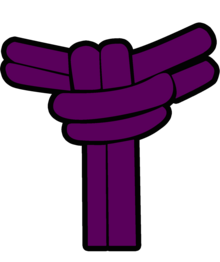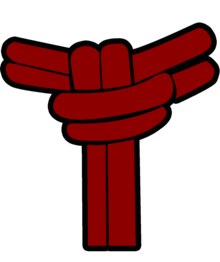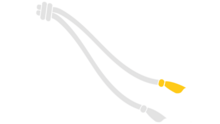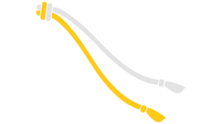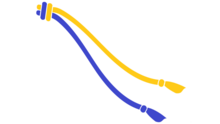| Also known as | Associação Brasileira de Apoio e Desenvolvimento da Arte-Capoeira (The Brazilian Association for the Support and Development of the Art of Capoeira) |
|---|---|
| Date founded | 1988 |
| Country of origin | |
| Founder | Mestre Camisa (born 1956) |
| Current head | Mestre Camisa |
| Arts taught | Capoeira |
| Ancestor arts | Capoeira Regional • Capoeira Angola |
| Descendant arts | none |
| Ancestor schools | Academia-escola de Capoeira Regional |
| Official website | ABADÁ-Capoeira Brazil |
The Associação Brasileira de Apoio e Desenvolvimento da Arte-Capoeira (ABADÁ-Capoeira), in English translated as "The Brazilian Association for the Support and Development of the Art of Capoeira",[1] is a nonprofit organization whose purpose is to spread and support Brazilian culture through the practice of capoeira.[2] Founded in 1988 by Mestre Camisa, José Tadeu Carneiro Cardoso, ABADÁ is based in Rio de Janeiro, Brazil.[1] It is one of the largest capoeira organizations in the world with over 41,000 members[3] representing schools throughout every state of Brazil as well as 30 different countries.[2][4] ABADÁ is distinguished from other capoeira organizations by its worldwide growth as well as its style, standards, and philosophy.
YouTube Encyclopedic
-
1/1Views:1 464
-
ABADÁ - CAPOEIRA JOGOS BRASILEIROS 2022
Transcription
Style, standards, and philosophy
Style
"ABADÁ-Capoeira prides itself on the originality and constant refinement of its style of capoeira, renown [sic] for its efficiency, aesthetics, and its cultural and historical relevance", explains ABADÁ-Capoeira San Francisco.[5] Part of the contemporary renaissance of capoeira,[6] ABADÁ-Capoeira seeks to incorporate the practices of the two main branches of the art, Capoeira Regional and Capoeira Angola.[5] Its instruction embraces the fundamental customs of the time-honored art while at the same time engaging the modernizing advances of recent Mestres, in particular Mestre Bimba.[5] An aluno formado of Mestre Bimba, Camisa "developed his own philosophy and methodology for teaching capoeira by following the innovative concepts of his teacher, the great master of Capoeira Regional, Bimba. Mestre Camisa's vision for ABADÁ-Capoeira has been to create an organization that strives to move forward by keeping one foot in the past and one foot in the future, maintaining tradition while adapting to society's changes".[5]
Standards

As explained by ABADÁ-Capoeira San Francisco:
ABADÁ-Capoeira believes that the study of capoeira involves dedication to all the various aspects of the art, emphasizing in particular the relentless pursuit of technical mastery of the physical elements of capoeira and the constant evolution of the technique to improve efficiency and prevent injury. Equally important is the understanding of and reverence for capoeira's rich history, including the preservation and recovery of the instruments, rhythms, and games of capoeira, individual competency in and knowledge of the game’s music and instruments, and participation in the larger capoeira community in Brazil and throughout the world.[5]
As this last suggests, ABADÁ-Capoeira expresses itself not only as an athletic endeavor but also as a holistic practice that helps individuals develop as members of society at large.
Philosophy
As described by ABADÁ-Capoeira New York City, ABADÁ-Capoeira incorporates a multi-leveled philosophy aimed at sustaining the development of capoeira through its members as well as utilizing capoeira as tool for individual and communal growth.[7] At its base, the school stresses the "relentless pursuit of the technical mastery of capoeira, at both the student and instructor levels".[7] Training provides a solid foundation in the art’s movements and principles, promoting discipline as well as physical and mental awareness. Ongoing training recognizes the transformation of the student into a teacher as she or he progresses through various stages of development and returns his or her learned experience to the group. This process helps maintain the original value systems of the early capoeira masters, their culture and their life experiences, as the cycle of learning continues. At the same time, a dialogue opens by which the "teacher" is also informed and instructed by the "student" as the student marks her or his own personal achievements as a capoeirista.
Just as important, ABADÁ-Capoeira promotes capoeira as an artistic and cultural resource, as well as a valuable pedagogic tool. A holistic approach to all aspects of the art and its traditions, in particular the songs and instruments, helps maintain a firm connection to its Brazilian heritage.[7] At the same time, ABADÁ-Capoeira promotes creative exploration within the idea of "play". Capoeiristas do not exactly compete in the rodas, but rather strive with their partner to produce the best game possible, and this understanding of play extends into other aspects of the capoeirista’s training.
The school further seeks to "promote cultural and human values" based on respect, freedom, integrity, and strength.[7] Its social orientation also advocates community building, leadership in daily practice, and the pursuit of education. It hopes to accomplish these goals by spreading the art of capoeira in and through universities, schools, clubs, associations, and diverse communities. It also hopes to emphasize the cultural lessons inherent in its Brazilian roots, and by doing so, promote social integration between people of different backgrounds and classes. While keeping sight of its social goals, ABADÁ-Capoeira also seeks to instill good character, dignity, and strong personal values in its students.[5][7] Training thus reinforces personal integrity and can offer personal and spiritual examination.
History and Mestres
ABADÁ-Capoeira was officially established in 1988 in Rio de Janeiro. Mestre Camisa’s intention was to develop a group formally dedicated to the practice of the art which would also build a strong sense of family and community for the numerous capoeiristas. This worldwide community is guided by the school’s Mestres, who currently number six. In the tradition of capoeira, all practitioners are given an apelido, or nickname, establishing their identity within ABADÁ-Capoeira. Appelidos are typically assigned during batizado celebrations, when new members are welcomed into the community.[citation needed]

Mestre Camisa
Mestre Camisa, born José Tadeu Carneiro Cardoso, grew up on a farm known as Fazenda Estiva in northeast of Brazil, in the state of Bahia. He grew up with nine siblings, the eldest being Edvaldo Carneiro da Silva, who became the capoeirista Camisa Roxa. Mestre Camisa first began studying capoeira at about the age of seven, following the movements of others playing in neighborhood street rodas and instructed by his older brother Camisa Roxa, himself a student of the legendary Mestre Bimba.[8][9]
When Camisa turned 12 years old, Camisa Roxa convinced their mother to allow him to attend Mestre Bimba’s academy in Salvador, where he received more formal education in the art and was exposed to the diversity of practitioners gathered in the city.[8] After about a year, Camisa became an Aluno Formado, a graduated student of Mestre Bimba.[9]
In the early 70’s, Camisa joined his brother in a year-long tour of Brazil with the folkloric dance company Olodum Maré, also known as the Grupo Folclórico de Bahia,[10] which performed traditional arts including capoeira.[8][9] The tour included three months of performances in Rio de Janeiro before the troupe departed for a reformulated tour of Europe.[8][9] Mestre Camisa stayed in Brazil, as he was supposed to return to Salvador to complete his studies;[9] instead, he remained in Rio and began earning his living by teaching capoeira.[8][9]
His first few months in Rio were difficult personally as he was basically poor and did not have established friends or connections in the city.[8][9] He began to offer training in capoeira and slowly gained students.[9] It was during this first period in Rio that Mestre Camisa first began to consider the need to design a formal structure for classes, to draw up a basic lesson plan, to create a place for studying and teaching, a place to debate techniques and discuss concepts. In addition, he felt the need to give a family-like structure to so many people who had left behind their cities and their friends and families and moved to Rio to dedicate themselves to capoeira. The latter was the main impetus for the creation of a new organization that would, in 1988, become ABADÁ-Capoeira.[8]
Since the beginning of the 1980s, Mestre Camisa had been drawing on his experience in Mestre Bimba’s Academy to develop his own style and build his school. His unique technique and methodology improved the martial aspect of capoeira, and established him as the leading capoeira master in the world. Since he does not have a massive physique, Camisa developed a technique to neutralize his opponent with slips, takedowns, speed, and efficiency in the application of the moves, blows, and kicks. This technique allows him to face a bigger opponent under equal conditions.[8]
Mestre Camisa is constantly researching capoeira and improving his style. He teaches workshops and seminars and attends batizados in Brazil and throughout the world. Through ABADÁ-Capoeira, Mestre Camisa is defining a new contemporary language of capoeira that seeks to respect and preserve the traditions and foundations of capoeira, and to follow all aspects of its evolution—as a martial art, as a playful game, as a source of rhythms and songs, and as a spontaneous art form—as the schools expand throughout the world.[8] He has become eminently respected in Brazil and in the worldwide capoeira community for his contributions to the art. In Capoeira: A Brazilian Art Form, Bira Almeida, "Mestre Acordeon," notes, "Camisa [is] one of the best contemporary teachers and a very accomplished capoeirista, who has been training ceaselessly since he was twelve. Influenced by his older brother, Camisa Rôxa, Camisa's strong commitment to Capoeira is reflected in his maturity in the art and in the result of his work."[11]
Grão Mestre Camisa Roxa
Grão-Mestre Camisa Roxa was born Edvaldo Carneiro da Silva in 1944 and spent his childhood on the Fazenda Estiva, a farm in the interior of Salvador, Bahia. He was the eldest of ten children, and he was greatly respected by his younger siblings, a number of whom followed in his footsteps in life and in capoeira.[12]
As detailed by ACNYC:
When he was 10 years old, Grão-Mestre Camisa Roxa began to play capoeira. At the time, it was only one of the many games he played to entertain himself and to pass the long hours of childhood. He had no idea that, 19 years later, he would be a professional capoeirista and the first to carry his art outside of Brazil, first to Europe and then around the world.
Camisa Roxa first made his name as a capoeirista in Salvador, Bahia, as a student of Mestre Bimba. In the 1960s, he left his family ranch for the capital city in order to complete his high school education. In addition to his school work, he also began studying capoeira at Bimba’s Academy. He was an apt and hard working pupil, and eventually gained recognition as Bimba’s best student.[12]
His talent and knowledge of capoeira became recognized throughout the community as he sought out other capoeiristas: playing in the rodas at Mestre Pastinha's academy and in the rodas of Mestres Valdemar and Traira on Pero Vaz Street, Camisa Roxa became very highly regarded.
When he was 21, Grão-Mestre Camisa Roxa's father died, and he became the patriarch of his family. He took on the responsibility of educating his brothers and sisters and providing for their general welfare. He became their second father, and was greatly admired by all. In fact, three of his brothers—Ermival, Pedrinho, and José Tadeu—followed in his footsteps, training capoeira with Mestre Bimba at his academy in Salvador. Like their brother, all three became alunos formados, graduates, of the Acadamia de Mestre Bimba.[12]
Camisa Roxa eventually began teaching capoeira in a number of academies and clubs in Salvador. Inspired by the idea of spreading the practice of capoeira, Camisa Roxa helped form the folkloric dance company Olodum Maré, a travelling performance group to promote traditional arts, including capoeira, throughout Brazil. After completing a year-long tour of the country, the group planned a tour of Europe under the name "Brasil Tropical."[8][9][13]
When the troupe embarked in 1973, "few people believed that his voyage would meet with success. Yet, trusting in his vision, his talent, and in the power of capoeira, Camisa Roxa made the journey and [he and the troupe were] very well received. That trip was the first step towards what has now become the internationalization of capoeira".[12] In Capoeira : A History of an Afro-Brazilian Martial Art Matthias Röhrig Assunção states, "Important for the diffusion of capoeira in Europe during the 1970s was Brazil Tropical, a company headed by the dancer and choreographer Domingos Campos and M. Camisa Roxa. Camisa Roxa, a student of M. Bimba, was at the time considered to be one of the best Regional players of Brazil."[14] The Brasil Tropical troupe would become dedicated to promoting the art of capoeira throughout the world. Though the art remains firmly rooted in Brazil, it has been planted in 40 countries around the world, largely as a result of the travels and the work of Grão-Mestre Camisa Roxa.[12]
Grão Mestre Camisa Roxa has lived the last years in Austria. He has coordinated centers of ABADÁ Capoeira in Europe and he has been the organizer for the ABADÁ Capoeira "Jogos Europeus".[15] He died 18 April 2013 in Salvador (Brasil)[16][17]
Mestre Cobra
This bio originally appeared at the website for ACNYC. This version has been significantly edited for grammar, translation, and stylistic errors; the content has not been altered.
Mestre Cobra, Antonio Marcelo Rodrigues Trinade, was born in Amparo—a city in the interior of the state of São Paulo—on November 18th, 1963. As a teenager he used to watch capoeira rodas around town with friends. Capoeiristas noticed his interest in the art and invited him to train at the local capoeira school where he met Mestre Carlão. Cobra was the oldest of four children, so by the time he turned sixteen, he was working as a weaver to help support his family. Every day after work he went to the capoeira school and became one of Carlão's most dedicated students.
Capoeira also helped him overcome one of the most difficult moments of his life: the early loss of his mother when he was 16 years old. The family experienced difficult moments with the separation of the brothers while the father, who was a traveling salesman, was reorganizing the structure of the family. "At [that] moment capoeira was my escape valve; [it's] what held me together, and this gave me motivation," explains Cobra.
Cobra trained in the city of Amparo for six years, hearing stories of great capoeiristas and about capoeira in Rio de Janeiro. Mestre Carlão spoke about Camisa not only as a great capoeirista, but also in reference to his personality, the work he was doing, and his preoccupation with the direction in which capoeira was heading. These conversations sparked Cobra’s interest in going to Rio de Janeiro to meet Mestre Camisa. During a trip to Acres for a batizado at the school of Mestre Rodolfo (the Mestre of Carlão), Cobra met Mestre Camisa and asked if he could go to Rio de Janeiro to take a class with him; Mestre Camisa agreed. Cobra held the rank of Graduado and taught capoeira in Amparo, but he had many financial difficulties. Despite that, Cobra began saving money for the trip to Rio.
In December 1984, Cobra went to Rio with just enough money to watch one of Camisa’s classes and return to Amparo the next day. When he arrived at the class, he was told that Mestre Camisa was at the Circo Voador (The Flying Circus), organizing the First National Capoeira Encounter. When Cobra arrived at the Circo Voador, he saw Mestre Rodolfo, who told him it was very important that Cobra participate in Camisa’s event. Mestre Rodolfo paid for Cobra's hotel and meals for a week, which he remembers today as the greatest gift of his life. He reflects, "At that point I realized my destiny was going to change…I understood how advanced capoeira was in Rio de Janeiro compared to the rest of the country; I was fascinated by the world of capoeira and its leadership here in Rio de Janeiro".
From 1985 to 1986, Cobra trained monthly in Rio de Janeiro. He spent a week at the “Associação” in Botafogo, where he trained daily from 4–6 PM with Mestre Camisa and 7–10 PM with Mestre Caio before returning to São Paulo. In 1987, Cobra decided to move to Rio de Janeiro permanently. Cobra informed Mestre Carlão about his decision. In response, Mestre Carlão asked Mestre Camisa to welcome Cobra, saying he was a good man to have by his side. And so Camisa gave Cobra a small room at the Associação, the capoeira school where Camisa once taught.
"That little room was like a five star hotel; a place where I can live and train…it was the best", Cobra would recall. He began to train consistently with Mestre Camisa and soon took on organizing events and social projects. As Mestre Camisa developed ABADÁ-Capoeira in the late 1980s, Cobra stood by his side, and he has ever since. As the ABADÁ organization grew, so did Mestre Cobra’s popularity as one of the most technical capoeiristas in Rio.
Mestre Cobra has not stopped giving workshops and seminars throughout the world. In 1993 he received the rank of Mestrando, and in 2005 he was recognized as a Mestre. Mestre Cobra has mentored hundreds of students and has been an essential piece in the growth of ABADÁ-Capoeira.[18]
Mestre Morcego
Rogério Francisco da Silva, was born in Rio de Janeiro and began training capoeira in 1981. Mestre Morcego began training with Mestre Camisa at the Santa Luzia Regatta and Swimming Club in Aterro do Flamengo, RJ, Brazil. In 1989, he received the brown cord. In 1991, Mestre Morcego along with Mestres Cobra and Canguru, were the first to receive the brown and red cords of Abadá-Capoeira. In 1995, he received the red cord and was recognized as Mestrando Morcego. In 2011, he was recognized as Mestre by Mestre Camisa and Abadá-Capoeira. During the period from 1984 to 2011, Mestre Morcego balanced his time between being an active member of the Marine Corps of Brazil and as a capoeirista. Today, however, Mestre Morcego is solely dedicated to capoeira! He supervises and guides the members of the Abadá School. Mestre Morcego travels internationally in order to teach up to date technical courses. Mestre Morcego is fluent in English thus facilitating the dynamics of his teachings.
Mestre Canguru
Waldec Velasco Cota.
Started capoeira in 1980. Became a Mestrando in 2000 and a Mestre in 2013.
He currently lives and teaches in Rio de Janeiro.
Mestra Edna Lima
Edna Lima.
Mestra Edna started training capoeira in 1975. She is also a black belt in karate. She became a Mestranda in 1997 and a Mestra in 2013. Mestra Edna created Capoeira Workout which is based on capoeira moves.[19]
She currently lives and teaches in New York City.
Mestra Márcia Cigarra

Márcia Treidler.
Started Capoeira in 1982. Became a Mestranda in 1997 and a Mestre in 2013.
She currently lives and teaches in San Francisco.
Mestrandos
The elite group of Mestrandas and Mestrandos in ABADÁ-Capoeira’s forty-thousand-member organization contains 25 individuals who have made life-long commitments to the art of capoeira. Their enduring dedication has been instrumental in maintaining the distinctive technique and philosophy of ABADÁ-Capoeira. Led by the Mestres, these Mestrandos/as oversee ABADÁ-Capoeira throughout the world to ensure that its style, technique, and philosophy are preserved, and, above all, that the art of capoeira continues to expand without jeopardizing its essence. The Mestrandos/as, together with the Mestres, are also responsible for the further enhancement of movements, norms, and ethics within the organization.[20]
| Training Capoeira Since: | Recognized as a Mestrando/a: | Teaches in: | |
|---|---|---|---|
| Mestrando Tigre,
Francisco Alves Filho[21] |
1984 | 2013 | Belgium[21] |
| Mestrando Cascao,
Luiz Fernando Pereira Monteiro[22] |
1983 | 2013 | Portugal[22] |
| Mestrando Bode,
Cassius Vinicius Caetano Guimarães[23] |
1987 | 2013 | Florianópolis[23] |
| Mestrando Pretão,
Lucio Oliveira |
1977 | 2019 | Alemanha |
| Mestrando Cafuzo,
Joel Benedito dos Santos |
1984 | 2021 | Espanha |
Cord System

ABADÁ has a graduated cord system using colors that refer symbolically to nature and reflect the level of practice.[24] The cord system does not so much reflect the practitioner’s level of skill as much as their progress on their individual path as a member of the ABADÁ community. The cord system as outlined by Arte Capoeira Center – ABADÁ Capoeira is as follows.
Adult Graduation System
See also
Notes
- ^ a b ABADÁ-Capoeira, San Francisco. (21 July 2009) "International Affiliation" Archived 18 March 2009 at the Wayback Machine. ABADÁ-Capoeira Overview. Retrieved 21 July 2009.
- ^ a b ABADÁ-Capoeira. (26 June 2006) "Archived copy". Archived from the original on 1 June 2009. Retrieved 12 June 2009.
{{cite web}}: CS1 maint: archived copy as title (link) "O que é ABADÁ". ABADÁ-Capoeira. Retrieved 22 July 2009. - ^ Lopez, Corey. "ABADÁ-Capoeira at Ethnic Dance Festival". San Francisco Chronicle (24 June 2008): E-1. Retrieved 18 July 2008. http://www.sfgate.com/cgi-bin/article.cgi?f=/c/a/2008/06/24/DD78116Q9V.DTL
- ^ "Capoeira-Abadá [sic] represents maybe the largest capoeira group to date, counting 20,000 members in 1996, and 25,000 in 1998, spread over 25 Brazilian states and 16 countries in five continents." From Assunção (2005, p.194)
- ^ a b c d e f ABADÁ-Capoeira, San Francisco. (21 July 2009) "Abadá-capoeira san francisco". Archived from the original on 18 March 2009. Retrieved 21 July 2009. "ABADÁ Style". ABADÁ-Capoeira Overview. Retrieved 21 July 2009.
- ^ "Currently the expression capoeira contemporânea is more widely used to designate all 'hybrid' styles." From Assunção (2005, p.199).
- ^ a b c d e ABADÁ-Capoeira, New York. (24 April 2006) "ABADA CAPOEIRA - >> about abada capoeira <<". Archived from the original on 14 July 2009. Retrieved 23 July 2009. "Philosophy". About ABADÁ. Retrieved 22 July 2009.
- ^ a b c d e f g h i j ABADÁ-Capoeira, New York. (24 April 2006) "Mestre Camisa's Bio" Archived 14 July 2009 at the Wayback Machine. About ABADÁ. Retrieved 18 July 2008.
- ^ a b c d e f g h i ABADÁ Capoeira, RPI. (27 July 2009) "Mestre Camisa and ABADÁ" Archived 10 June 2010 at the Wayback Machine. History. Retrieved 27 July 2009.
- ^ Almeida (1986, p.56)
- ^ Almeida (1986, p.47)
- ^ a b c d e ACNYC. (27 July 2009) "Grao Mestre Camisa Roxa" Archived 5 June 2008 at the Wayback Machine. ABADÁ Capoeira: Masters. Retrieved 27 July 2009.
- ^ Almeida (1986, p.46-47)
- ^ Assunção (2005, p.190)
- ^ ABADÁ-Capoeira. (26 June 2006) "Archived copy". Archived from the original on 1 June 2009. Retrieved 12 June 2009.
{{cite web}}: CS1 maint: archived copy as title (link) "Grão Mestre Camisa Roxa". Mestres. Retrieved 18 July 2008. - ^ "Portal da Revista Capoeira – Fotos, vídeos, eventos, notícias, entrevistas, mestres e muito mais! » Nota de falecimento – Mestre Camisa Roxa (1944-2013)". Archived from the original on 27 March 2014. Retrieved 20 April 2013.
- ^
(26 June 2006) "Archived copy". Archived from the original on 1 June 2009. Retrieved 12 June 2009.
{{cite web}}: CS1 maint: archived copy as title (link) "Grão Mestre Camisa Roxa". Mestres. Retrieved 18 July 2008. - ^ Unknown. Revista ABADÁ-Capoeira, August 2005. Quoted from ACNYC. (27 July 2009) "ABADA Capoeria of New York City [ACNYC]". Archived from the original on 5 June 2008. Retrieved 27 July 2009. "Mestre Cobra." ABADÁ Capoeira: Masters. Retrieved 27 July 2009.
- ^ "EDNA LIMA and ABADÁ CAPOEIRA". Archived from the original on 21 June 2020. Retrieved 23 July 2020.
- ^ ACNYC. (27 July 2009) "Mestrandos of ABADÁ-Capoeira" Archived 21 February 2009 at the Wayback Machine. ABADÁ-Capoeira: ABADÁ-Capoeira Masters. Retrieved 27 July 2009.
- ^ a b ABADÁ-Capoeira Washington DC. (6 September 2013) [1]. "Mestrando Tigre".ABADÁ-Capoeira Washington DC: Mestres and Mestrandos. Retrieved 11 November 2011.
- ^ a b ABADÁ-Capoeira Washington DC. (6 September 2013) [2]. "Mestrando Cascao".ABADÁ-Capoeira Washington DC: Mestres and Mestrandos. Retrieved 11 November 2011.
- ^ a b ABADÁ-Capoeira Washington DC. (6 September 2013) [3]. "Mestrando Bode".ABADÁ-Capoeira Washington DC: Mestres and Mestrandos. Retrieved 11 November 2011.
- ^ a b Arte Capoeira Center – ABADÁ Capoeira. (21 July 2008) "Arte Capoeira Center - ABADÁ Capoeira - ABADA Capoeira Cord System". Archived from the original on 23 May 2009. Retrieved 24 May 2009. "ABADÁ Cord System". ABADÁ. Retrieved 21 July 2008.
References
- Almeida, Birra "Mestre Acordeon" (1986). Capoeira: A Brazilian Art Form. Berkeley: North Atlantic Books. ISBN 0-938190-30-X.
- Assunção, Matthias Röhrig (2005). Capoeira : A History of an Afro-Brazilian Martial Art. New York: Routledge. ISBN 0-7146-8086-9.
External links
- ABADÁ-Capoeira Archived 1 June 2009 at the Wayback Machine Home page under Mestre Camisa (Brazil)
- ABADÁ-Capoeira World ABADÁ-Capoeira around the world.
- ABADÁ-Capoeira DC (ABADÁ-Capoeira in the Washington D.C. Metro Area)











